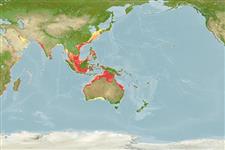Common names from other countries
Environment: milieu / climate zone / depth range / distribution range
Ecología
Bentopelágico; rango de profundidad 0 - 200 m (Ref. 81173), usually 1 - 40 m. Tropical; 30°N - 37°S, 32°E - 178°W
Indo-Pacific: Dugong dugon hemprichii: Red Sea, Aqaba, Suez Canal; Dugong dugon dugon: Gulf of Aden, Mozambique, Persian Gulf, Pakistan, India, Myanmar, Malay Peninsula, Gulf of Thailand, Vietnam, Gulf of Tonkin, Comoros, Madagascar, Mauritius, Rodriguez, Sri Lanka, Andaman Islands, Indonesia, Ryukyu, Taiwan, Philippines, Guam, Palau, Micronesia, Caroline Is, Papua New Guinea, Solomon, New Caledonia, Australia, Fiji (Ref. 1522).
Length at first maturity / Tamaño / Peso / Age
Maturity: Lm ? range ? - ? cm Max length : 406 cm TL macho / no sexado; (Ref. 91927); peso máximo publicado: 400.0 kg (Ref. 1394); edad máxima reportada: 20 años (Ref. 91927)
Maximum diving depth of 20.5 m recorded from Australia (Ref. 81173). Found in inshore waters, in bays and channels (Ref. 1394). Favors areas with warm shallow water, inshore and reefal seagrass beds (Ref. 936), particularly on fine sand (Ref. 86921). Occurs in small groups of up to 6 individuals; though, an exception of a herd of to 600 individuals was once recorded between Bahrain and Qatar (Ref. 801). Population estimates in the Persian/Arabian Gulf range from 5800 to 7300 individuals. Has a larger range than previously known, where their present range may be about 74% of the historical range (Ref. 114880). Feeds on a variety of seagrasses (Ref. 936). Almost entirely dependent on seagrass for food (Ref. 114880). Preyed upon by tiger sharks (Ref. 49538). Faces threats in the Persian/Arabian Gulf such as dredging, trawling and land reclamation, all damaging their critical seagrass habitats (Ref. 114880).
Tan, J.M.L. 1995. (Ref. 936)
IUCN Red List Status (Ref. 130435)
CITES status (Ref. 108899)
Human uses
Pesquerías: sin interés
FAO - pesquerías: species profile | FishSource | Sea Around Us
Herramientas
Fuentes de Internet
Estimates based on models
Preferred temperature
(Ref.
115969): 24 - 29, mean 27.8 (based on 1686 cells).
Resiliencia
Alto, población duplicada en un tiempo mínimo inferior a 15 meses (K=1.26-1.62; tm=12.3; tmax=20).
Vulnerability
Very high vulnerability (90 of 100).
Price category
Unknown.
